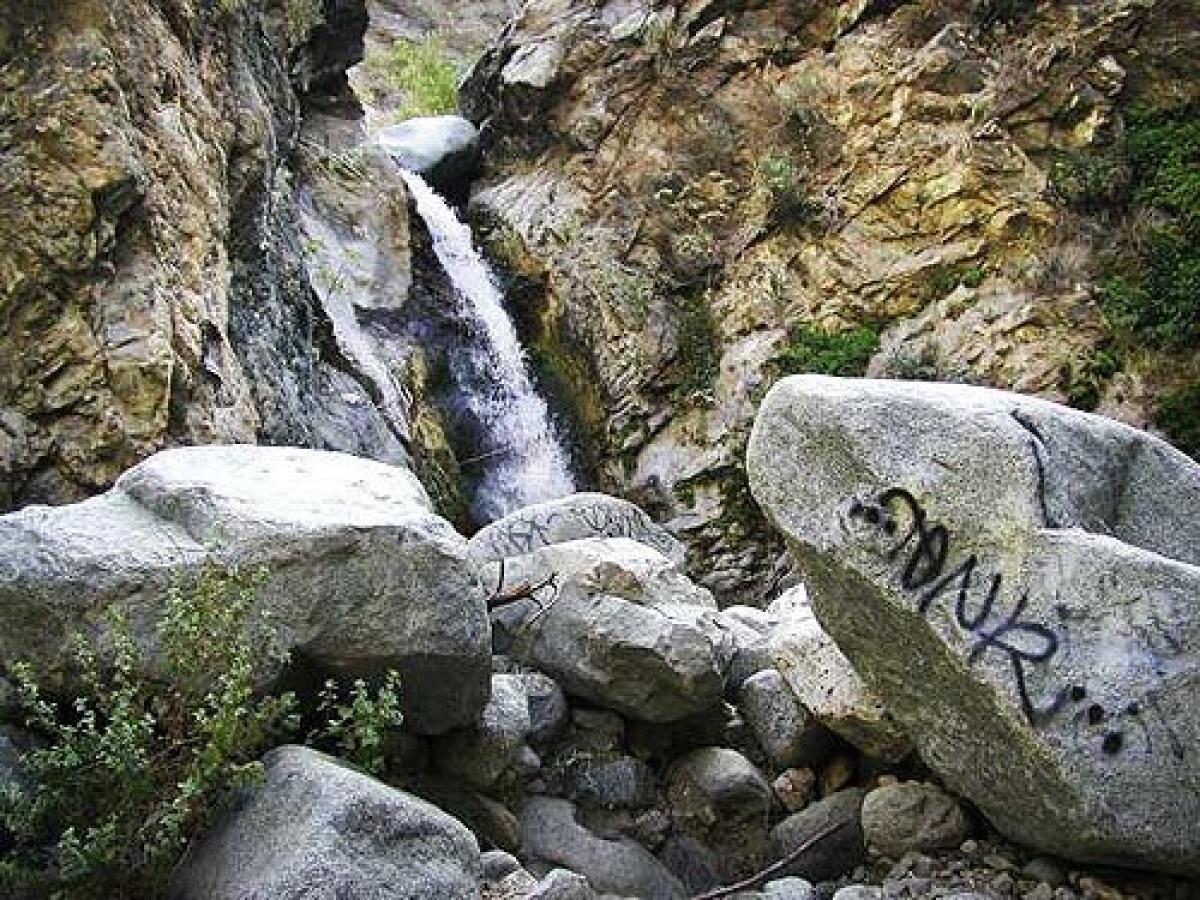Smear tactics

- Share via
THE sound of crashing water grows louder as a narrow dirt trail winds through Eaton Canyon above Pasadena. Rounding a bend, though, it’s not the 50-foot waterfall that captures the eye, but graffiti scribble on boulders and canyons encircling the cascade.
City walls and freeway overpasses have long presented a canvas for taggers. Rangers and park officials say vandals are increasingly unleashing their spray cans and permanent markers in parks, canyons and wilderness areas.
While large expanses of wild lands remain unmarred, officials say the problem is growing. In some natural areas, a multicolor mess of block letters, expletives and gang symbols make traditional “John loves Mary” tree-trunk carvings look tame. And it’s hard to remove graffiti from remote areas where access is difficult.
Most of the scrawl is on cliffs, rocks, trees and bridges near Los Angeles, San Diego and San Francisco. It’s also a significant part of the landscape in areas of Topanga State Park, Anza-Borrego Desert State Park and Sequoia and Kings Canyon National Parks.
A spate of graffiti even marred Yosemite National Park on Memorial Day two years ago when rangers found large black letters smearing rocks on a trail leading to the summit of Half Dome.
“We don’t know why it’s occurring right now,” says Bob Soots, head of special operations for the Los Angeles County Department of Parks and Recreation. His agency manages 150 miles of backcountry trails and relies on hikers to report vandalism.
Just last week, Soots received a report from a hiker about graffiti on the Michael D. Antonovich Trail near San Dimas. When his crews went to investigate, he says they discovered vandals had spray-painted trees, boulders and concrete footings.
Some park officials suggest the increase in graffiti is the result of more visitors to local, state and national parks.
“We used to have a few thousand visitors and today we have a couple of million people,” says Alexandra Picavet, a ranger at Sequoia-Kings Canyon.
Timothy Kephart, an anti-graffiti consultant with the city of Carson, says middle-class suburban youths who travel to national parks and mountain trails are doing more of the tagging. Rocks are permanent and isolated, he says, “so the kids know the graffiti will be up for a while.”
Diana Lindsay, a guidebook author and tour leader at Anza-Borrego, says she feels angry and hurt when she finds names and initials scratched into caves in Arroyo Tapiado Canyon and the sandstones near Fish Creek.
“I think, ‘How can they do this to my state park?’ ” she says.
Lindsay feels that the markings impede her sense of solitude when she’s out on the trails. In an urban setting, anti-graffiti crews can paint over the markings on alleyways and freeway sound walls, but a cover-up is not so easy in the backcountry.
Slapping on a coat of rock-color paint temporarily removes the problem, but it’s unnatural and provides taggers a new canvas, park officials say. Washing the paint with cleaning solution could poison plants or animals or contaminate nearby waterways with solvents, including toluene, ketones or methylene chloride.
Because rocks are porous, spray paint seeps deep into the boulders and canyon walls. Rangers and park officials say the most effective way to erase paint on rocks is with a high-pressure sandblaster.
“It’s almost like you have to shave off a new surface,” said Kathy Dice, a supervising ranger at Anza-Borrego.
But getting a 50-pound sandblaster and an air compressor into a backcountry canyon can be a challenge. At Sequoia and Kings Canyon crews recently used a helicopter to lower a sandblaster into the backcountry to remove graffiti, Picavet says.
“If you leave it and don’t do that, it grows,” she says. “It metastasizes like a cancer.”
Eaton Canyon Natural Area in the San Gabriel Mountains is within the jurisdiction of L.A. County’s Department of Parks and Recreation, which struggles to control graffiti at inner-city parks.
Sheila Ortega, a spokeswoman for the department, says the agency doesn’t have the personnel and money to sandblast Eaton Canyon and other wilderness areas. Instead, she says, crews typically paint over graffiti.
But she is hopeful progress will be made because the L.A. County Board of Supervisors recently approved funding to add a third graffiti abatement crew.
In the Santa Monica Mountains National Recreation Area, park ranger Bonnie Clarfield packs towels containing a nontoxic cleaning agent she uses to scrub graffiti off of kiosks, restrooms and signs.
But when she runs into graffiti on boulders or masonry walls, Clarfield says all she can do is rub the markings with another rock or cover the scrawl with mud.
“I have to use elbow grease a lot,” she says.
*
Hugo Martín can be reached at hugo.martin@latimes.com.
More to Read
Sign up for Essential California
The most important California stories and recommendations in your inbox every morning.
You may occasionally receive promotional content from the Los Angeles Times.










